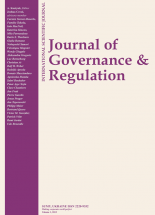Journal of Governance and Regulation: Volume 5, issue 4 has been published

The recent (Volume 5, issue 4) issue of the Journal of Governance and Regulation pays attention to issues of gender quota in boards, evolution of corporate governance in crisis, CSR and firm value, auditor’s judjement, professional forecasts and monetary policy, credit risk models in financial institutions and balancing state budget. More detailed issues are given below:
Annika Galle analyses the application of “gender quota” rule in the Netherlands through content analysis of the annual reports of 52 listed companies in 2012 and 49 in 2013. Ichiro Iwasaki traces back structural changes in the corporate governance system before and after the global financial crisis. This research also empirically examines the impacts of the crisis on the organization of boards of directors and audit systems. Hassan M. Hafez evaluates the effect of CSR on firm value and financial performance in Egypt. The author proves that CSR has a insignifcant negative effect on firm value and a signifcant positive effect on firm’ financial perfromance in Egypt measured by Return on Assets (ROA) and Return on equity (ROE). Hussein Mohammed Alrabba examined the impact of code of ethics on the quality of auditors’ professional judgment. The study found out that different aspects of auditors have varied influences on their ability to detect any incorrect information in accounting statements. Salminah Pulumo and Leroi Raputsoane analyse the accuracy of professional forecasts of monetary policy interest rate decisions in an emerging country. The results show that the forecasts of insurance companies and international banks are closest to the realised monetary policy interest rate on average based on proximity, while the forecasts of banks and interest groups are closest to the realised monetary policy interest rate based on temporal structure.
Poomjai Nacaskul elaborates the conceptual and technical links between credit risk modelling and capital adequacy framework for financial institutions, proffer a simple and intuitive taxonomy on contemporary credit risk modelling methodologies, and discuses in some details a number of key models pertinent, in various stages of development, to various application areas in the banking and financial sector. John Stevenson describes and contrasts two types of markets: markets with conventional resting orders versus markets with resting that orders that include optionality. A valuation method for these very short expiry options on the later marketplace is proposed. Appropriate historical volatility metrics are defined and applied for these uniquely short expiry timescales. Pilar Piqué analyzes a little explored work of Adam Smith: his Lectures on Jurisprudence, understanding it as a "bridge" between his Moral Philosophy and his Political Economy. Sven Larson, suggesting that the United States needs budget-balancing regulations, possibly at the constitutional level, explores two types of balanced-budget measures: deficit-elimination and debt-capping. Tamer A. El Nashar examines the impact of inclusive business on the internal ethical values and the internal control quality while conceiving the accounting perspective.
To access the issue of the journal visit this page.
We hope that you will enjoy reading the journal and in future we will receive new papers, outlining the most important issues and best practices of regulation and governance!
For submission details look here.
















